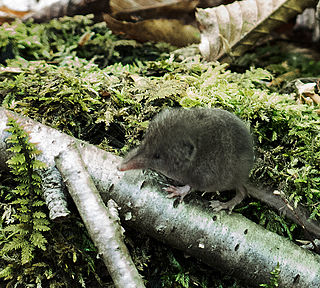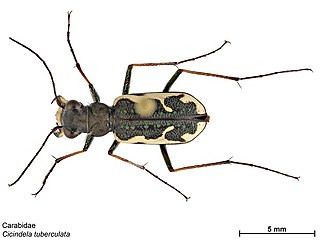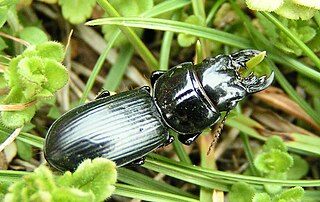
Ground beetles are a large, cosmopolitan family of beetles, the Carabidae, with more than 40,000 species worldwide, around 2,000 of which are found in North America and 2,700 in Europe. As of 2015, it is one of the 10 most species-rich animal families. They belong to the Adephaga. Members of the family are primarily carnivorous, but some members are herbivorous or omnivorous.

The insects of the beetle family Chrysomelidae are commonly known as leaf beetles, and include over 37,000 species in more than 2,500 genera, making up one of the largest and most commonly encountered of all beetle families. Numerous subfamilies are recognized, but the precise taxonomy and systematics are likely to change with ongoing research.

The North American least shrew is one of the smallest mammals, growing to be only up to 3 inches long. It has a long pointed snout and a tail never more than twice the length of its hind foot. The dense fur coat is either grayish-brown or reddish-brown with a white belly. Its fur becomes lighter in the summer and darker in the winter. Although similar in appearance to several species of rodents, all shrews are members of the order Eulipotyphla and should not be mistaken for a member of the order Rodentia. The North American least shrew's eyes are small and its ears are completely concealed within its short fur, giving it very poor eyesight and hearing.

Coccinella septempunctata, the common ladybug, the seven-spot ladybird, is a carnivorous beetle native to the Old World and is the most common ladybird in Europe. The beetle is also found in North America, Central and Eastern Asia and regions with a temperate climate. Its elytra are of a red colour, but each punctuated with three black spots, with one further spot being spread over the junction of the two, making a total of seven spots, from which the species derives both its common and scientific names.

Neocicindela tuberculata is a species of tiger beetle in the family Cicindelidae, endemic to New Zealand. Its common names include common tiger beetle, moeone, and papapa, and in its larval stage penny doctor, butcher boy, kapuku, kui, kurikuri, moeone, and muremure. Neocicindela tuberculata was the first carabid beetle described from New Zealand. The species can run as fast as 5 miles per hour and are considered to be the fastest running beetles. Adult species prefer clay banks in summer and are good predators when in comes to insects.

The rock squirrel is a species of rodent in the family Sciuridae. It is native to Mexico and the Southwestern United States, including southern Nevada, Utah, Colorado, Arizona, New Mexico, West Texas, and the panhandle of Oklahoma.

Peripatoides indigo, the indigo velvet worm, is a velvet worm of the family Peripatopsidae. The Māori name for the velvet worm is ngaokeoke, from the Māori word 'ngaoki', to crawl.

Scarites is a genus of ground beetle native to the Palearctic, the Near East, North America and North Africa, India. There are more than 190 described species in Scarites with more than 55 described species from India.

Broscus cephalotes is a species of nocturnal, coastal ground beetle found throughout most of Europe. Its range spans from western Europe into western Siberia. The species was introduced recently in the eastern areas of Canada and has spread farther south and west into the United States. As a member of the family Carabidae, Broscus cephalotes is generally considered beneficial to humans due to its predatory habits. Their varied diet often includes crop pests and other small organisms.
Agonum belleri, sometimes called Beller's ground beetle, is a species of ground beetle in the Platyninae subfamily. Beller's ground beetle is found throughout wetlands in the Pacific Northwest in Oregon, Washington, and British Columbia.

Scarites quadriceps is a species of ground beetle in the family Carabidae. It is found in North America. It can be found beneath debris on the edges of fields or beaches.

Omophron nitidum, the shiny round sand beetle, is a species of ground beetle in the family Carabidae. It is found in North America within the United States, in areas such as Indiana, Minnesota, Nebraska, Alabama and Texas. Adults are nocturnal, spending their time in burrows and leaf litter during the day. The breeding of O. nitidum takes place from March to December.
Goniotropis kuntzeni is a species of ground beetle in the family Carabidae. It is found in Central America and North America. Adults can be found on trees at night. Larvae dig burrows that they close off with their terminal disk, capturing prey with their terminal disk and dragging prey into the burrow.

Scarites vicinus is a species of ground beetle in the family Carabidae. It is found in North America.
Scarites lissopterus is a species of ground beetle in the family Carabidae. It is found in North America.

Habroscelimorpha dorsalis, commonly known as the eastern beach tiger beetle, is a species of flashy tiger beetle in the family Cicindelidae. It is found in Central America and North America.
Scarites marinus is a species of ground beetle in the family Carabidae. It is found in the Caribbean Sea, Central America, and North America.

Galerita lecontei, the false bombardier beetle, is a species of ground beetle in the family Carabidae. It is found in the Caribbean Sea, Central America, North America, and the Caribbean. They are primarily characterized by their dark coloration, rapid movement, lifespan longevity, and nocturnal hunting behavior. Their elytra, which are the hardened forewings provide protection for their hind wings and exhibit a glossy texture. Many species within this family can secrete harmful chemicals as a defense mechanism against predators. Furthermore, this species has evolved various predator deterrents, often in the form of dischargeable glands near their abdominal area, a common feature across several beetle families, including Carabidae, Dytiscidae, and Gyrinidae.
Pterostichus algidus is a species of woodland ground beetle in the family Carabidae. It is found in North America.
Creophilus rekohuensis is a beetle of the Staphylinidae family, subfamily Staphylininae. This species occurs only on some small predator-free islands in the Chatham Islands, New Zealand, where it lives in seabird burrows. Its name derives from Rekohu, the Moriori name for Chatham Island.















